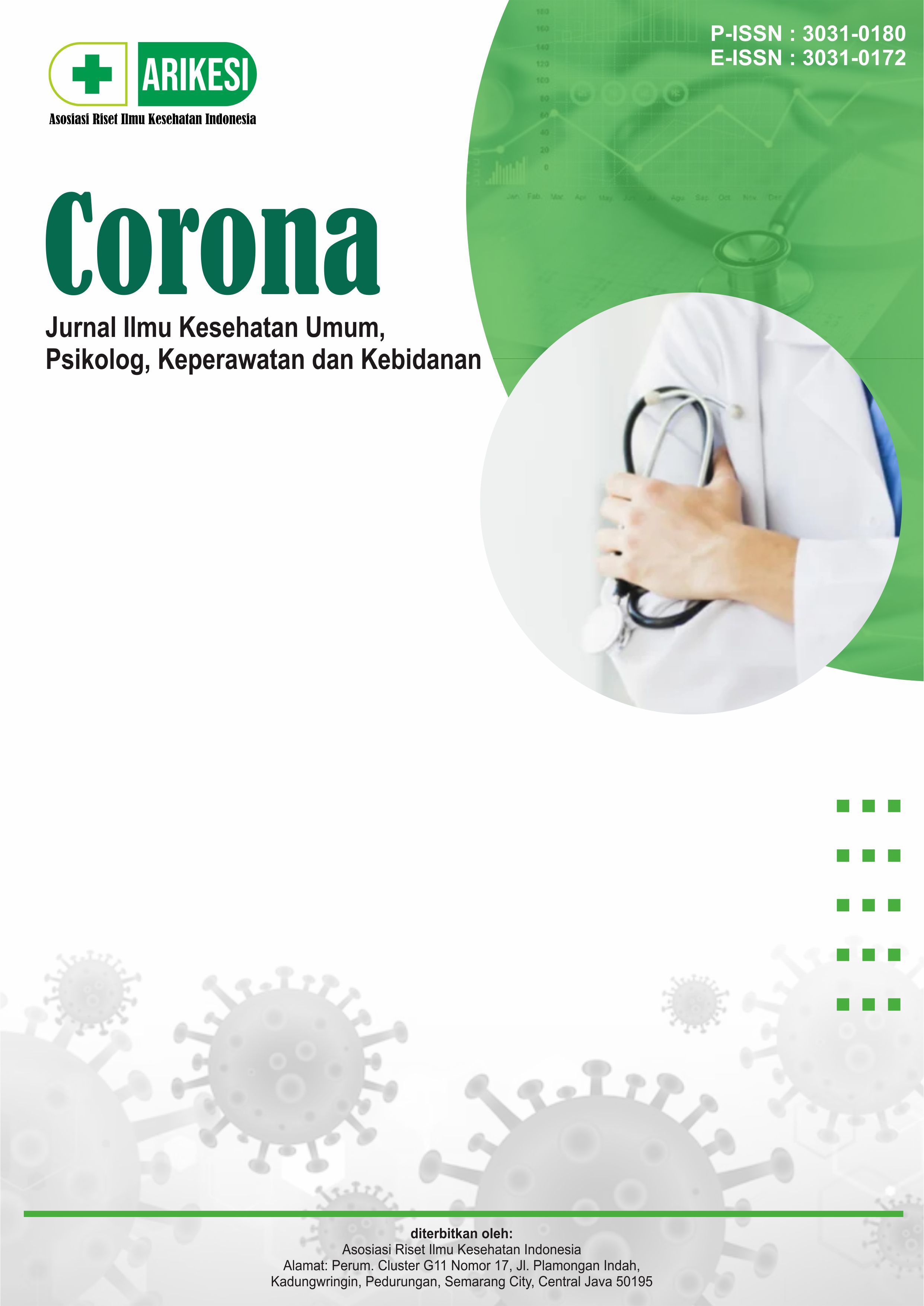Hubungan Perilaku dengan Kejadian Karies Gigi pada Siswa/Siswi Kelas IV di MIN 25 Aceh Besar
DOI:
https://doi.org/10.61132/corona.v2i4.889Keywords:
Behavior, Dental Caries, StudentsAbstract
In a study conducted at MIN 25 Aceh Besar, it was found that dental caries problems often occur in class IV students, with a significant influence from the lack of adequate knowledge, attitudes, and actions related to oral health. This cross-sectional analytic design study involved all fourth grade students as samples, totaling 72 people. Data were collected on May 2 and analyzed using univariate and bivariate methods with the chi square test. The results showed that most of the respondents had dental caries, where 39 out of 72 students (54.2%) suffered from the condition. The majority of respondents' knowledge about oral health was in the poor category, where 28 out of 72 students (38.9%) showed a low level of knowledge. This also applies to respondents' attitudes and actions, where 42 students (58.3%) have attitudes that are less supportive of good dental health and 46 students (63.9%) show ineffective actions in maintaining their oral health. Based on these data, there is a significant relationship between behavior (knowledge, attitude, and action) and the incidence of dental caries among these students, with the ρ value for knowledge being 0.003, attitude being 0.006, and action being 0.001. This shows that effective education and counseling on oral health is needed. As a recommendation, it is advisable for schools to collaborate with the local Health Office and Puskesmas to hold regular oral health counseling programs. In addition, establishing a healthy canteen at school can be another preventive measure so that students can choose healthier snacks that support good oral health.
Downloads
References
Elina, L. (2021). Instagram sebagai media edukasi peningkatan pengetahuan kesehatan gigi dan mulut. Jurnal Kesehatan Gigi (Dental Health Journal), 8(2), 51–56. http://repository.poltekkesbengkulu.ac.id/2451/1/SKRIPSI%20VINA%20VAULINA%20FIX.pdf
Elina, L. (2021). Instagram sebagai media edukasi peningkatan pengetahuan kesehatan gigi dan mulut. Jurnal Kesehatan Gigi (Dental Health Journal), 8(2), 51–56. http://repository.poltekkesbengkulu.ac.id/2451/1/SKRIPSI%20VINA%20VAULINA%20FIX.pdf
Hidayatullah, E. (2020). Hubungan perilaku pemeliharaan kesehatan gigi dengan karies pada siswa kelas III-V SDN I Klambu. Skripsi, Jurusan Keperawatan Gigi Politeknik Kesehatan Kemenkes Semarang.
Kemenkes RI. (2018). Infodatin pusat data dan informasi Kementerian Kesehatan RI tahun 2018. https://journal.stikespemkabjombang.ac.id/index.php/jikep/article/download/1170/773
Khairani, R. (2017). Hubungan pengetahuan dan sikap ibu terhadap terapi pijat pada bayi di Klinik Bersalin Nurhalma Hasibuan Pasar 10 Tembung Tahun 2017.
Masrurah, W. (2019). Hubungan pengetahuan dengan sikap ibu tentang pijat bayi di wilayah kerja Puskesmas Kuta Baro Kecamatan Kuta Baro Kabupaten Aceh Besar.
Mukhbitin, F. (2018). Gambaran kejadian karies gigi pada siswa kelas 3 MI AlMutmainnah. Jurnal Promkes, 6(2), 155–166.
Mustafa, R. W. (2021). Gambaran pengetahuan dan tingkat kecemasan kepala keluarga terhadap suntik vaksin Covid-19 di Desa Klieng Cot Aron.
Notoatmodjo, S. (2018). Metode penelitian kesehatan. Jakarta: Rineka Cipta.
Notoatmodjo, S. (2018). Promosi kesehatan dan perilaku kesehatan. Jakarta: PT. Rineka Cipta.
Nurwati, B. (2019). Hubungan karies gigi dengan kualitas hidup pada anak sekolah usia 5-7 tahun. Jurnal Skala Kesehatan, 10(1), 41-47. https://doi.org/10.31964/jsk.v10i1.164
Pakpahan, M., Siregar, D., Susilawaty, A., Mustar, T., Ramdany, R., Manurung, E., Sianturi, E., Tompunu, M., Sitanggang, Y., & Maisyarah, M. (2021). Promosi Kesehatan & Prilaku Kesehatan (1st ed.). Medan: Yayasab Kita Menulis.
Potter, P., & Perry, A. (2022). Buku Ajar Fundamental Keperawatan: Konsep, Proses, dan Praktik (Vol. 2, edisi ke-4) (Y. Asih, Trans.). Jakarta: EGC. https://repo.poltekkesmedan.ac.id/xmlui/bitstream/handle/123456789/5894/5.%20clarisa.pdf?sequence=1&isAllowed=y
Riskesdas Provinsi Aceh. (2018). Kebiasaan gosok gigi menurun saat pandemi Covid-19.
Sinaga, E. B., & Safari, F. R. N. (2022). Hubungan pengetahuan ibu tentang oral hygiene (kebersihan mulut) dengan tindakan penanganan stomatitis pada bayi usia 6-12 bulan di Klinik Bersalin Eliza Tahun 2021. Jurnal Maternitas Kebidanan, 7(1), 11-19.
Sugiyono. (2021). Metode penelitian kuantitatif, kualitatif, dan R&D. Bandung: Alfabeta.
Susi, K., Kustantiningtyastuti, D., & Yona, L. (2012). Hubungan kebiasaan anak menjaga kesehatan dan kebersihan gigi dengan karies molar pertama permanen pada murid sekolah dasar di Kecamatan Padang Timur Kota Padang. Andalas Dental Journal, BDJ, 3(1), 5-8.
Downloads
Published
How to Cite
Issue
Section
License
Copyright (c) 2024 Corona: Jurnal Ilmu Kesehatan Umum, Psikolog, Keperawatan dan Kebidanan

This work is licensed under a Creative Commons Attribution-ShareAlike 4.0 International License.





